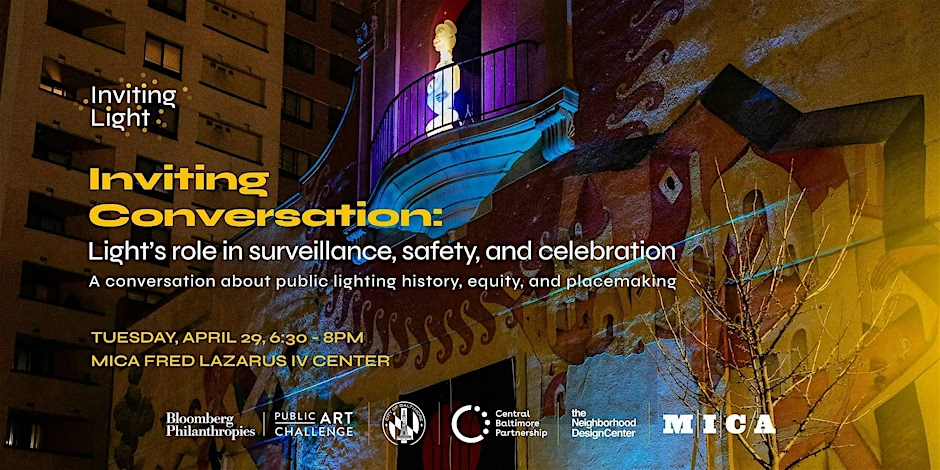
Panelists:
- Morris Speller, Lecturer in the Johns Hopkins University Writing program, urban historian focusing on race and racism in urban planning and the built environment
- Merrell Hambleton, Director of Public Engagement for the BMA, previous community engagement lead for Inviting Light and Signal Station North
- Glenn Shrum, Founding Principal of Flux Studio and Associate Professor of Lighting Design and Interdisciplinary Practice at Parsons School of Design (@flux_studio_ltd)
- Marie Anderon, Baltimore City Planner for the Northern District
- Moderator: Maura Dwyer, Community Design Works Project Coordinator at the Neighborhood Design Center
Description of Panel:
Light has always played a pivotal role in shaping public safety and nighttime activity. In fact, the first public light infrastructure wasn’t a physical object but people—a foot patrol carrying lanterns that became the first form of institutionalized police in Baltimore called the “night watchmen.”
Over time, the notion of “more light” equaling “more safety” and “less crime” became deeply ingrained, but Baltimore’s lighting infrastructure tells a more complicated story—one where the presence and type of light across different communities reflect structural inequities found in other forms of public infrastructure like green spaces, sidewalks, and streets. Just as light can welcome us in, it can also keep us out—making us feel uninvited or unwelcome in spaces that are deemed unsafe or off-limits.
This conversation brings together a local city planner, urban historian, public art and engagement specialist, and lighting designer to explore the nuanced legacy of urban lighting. They will delve into its dual role as a marker of progress and a mechanism of control, drawing insights from Baltimore’s history as the first U.S. city to install gas streetlights.
Panelists will examine projects like Signal Station North and Inviting Light to envision a future where light is reclaimed as a tool for community-defined safety, joy, access, culture, and belonging. Together, they’ll explore how equitable investment in thoughtful, creative public lighting can transform perceptions of unsafe spaces and revive vacant corridors—not through a one-size-fits-all approach, but by designing light to resonate with the unique nighttime environment, identities, and aspirations of each community.
From visibility, spectacle, and spiritual awakening to mood, memory, and resistance, this discussion invites us to reconsider the meaning of “lighting” a street—and asks, who gets to invite the light in?
**This is a FREE event open to the public. Reserve your spot!
Accessibility: The MICA Fred Lazarus IV Center is wheelchair-accessible. Thank you to the MICA Fred Lazarus IV Center for their support in providing space for this event.
About Inviting Light:
Informed by the Station North Public Space Plan and Signal Station North, a two-year community engagement, planning, and prototyping process that sought to understand light’s impact on the nighttime environment and our sense of comfort and place, illuminate the city’s lighting history and infrastructure, and bring transparency and access to everyday citizens, Inviting Light’s five distinct artistic light installations will promote safety and further revitalization efforts in a historically disinvested area.
Inviting Light is sponsored by Bloomberg Philanthropies and facilitated by Central Baltimore Partnership in partnership with the Mayor’s Office and Senior Advisor for Arts & Culture, and the Neighborhood Design Center.
For any questions, please email Catherine Borg at cborg@centralbaltimore.com
Get updates at invitinglight.org and Instagram @invitinglightbaltimore
Panelist Bios:
Morris “Mo” Speller completed a PhD in History from Johns Hopkins University in 2020. Before joining the UWP faculty in 2022, he previously taught in the program as an Allen Grossman Teaching Fellow and as a Post-Doctoral Fellow. He has taught history courses at Johns Hopkins, Maryland Institute and College of Art (MICA), and at the University of Maryland, Baltimore County (UMBC). In Spring 2020, Dr. Speller received the Ditz Prize in Teaching from the History Department of Johns Hopkins University.
Dr. Speller loves teaching, writing, and learning about Baltimore. In fall 2023, he received an Engaged Scholar Faculty Fellowship through the JHU Center for Social Concern, which has supported his collaborations with community partners including the Baltimore City Archives and the Peale Museum. His writing courses encourage students to think about how the past informs present-day life in Baltimore. Many of his writing courses incorporate digital and public humanities projects, which offer students opportunities to think about writing across multiple genres and for different audiences.
Dr. Speller’s primary research examines the history of mortgage discrimination, predatory lending, racial segregation, and housing policy in his hometown of St. Louis. His other research interests include the history of queer communities and “gayborhood” politics in Baltimore and the history of Baltimore neighborhoods displaced by urban renewal.
Merrell Hambleton (she/her) is the Director of Public Engagement, leading the BMA’s efforts to connect and collaborate with audiences in Baltimore City and beyond. Prior to joining the museum, Merrell led arts-based planning and cultural programming at the Neighborhood Design Center. In this role, she developed engagement strategies for landmark public art projects like the Bloomberg Philanthropies-supported Inviting Light and piloted an NEA-funded designer-in-residence program. Previously, Merrell produced public art projects with the artist Stephen Powers and the New York-based nonprofit Creative Time.
Merrell has presented her work at conferences hosted by AIA Baltimore, Project for Public Spaces, and others, and contributes reporting on art and design to publications like The New York Times, New York Magazine, and MOLD magazine. She holds a BA in history from Columbia University, an MA in social design and critical studies from MICA, and studied landscape architecture at Harvard’s Graduate School of Design. Merrell serves on the board of the Compound, a nonprofit artist studio and performance space in East Baltimore.
Glenn Shrum‘s work spans the fields of design and art practice, with light placing him at the center of converging professional disciplines. He transitioned from architecture to lighting to pursue the creative opportunity of light’s profound effect on space and people. Shrum maintains a dual professional identity as Associate Professor of Lighting Design and Interdisciplinary Practice at Parsons School of Design in New York City and founding principal of Flux Studio. In 2025, Glenn received a Lifetime Achievement Award from the Edison Report in recognition of his remarkable contributions to the lighting industry.
Marie McSweeney Anderson (she/they) is the Northern District Planner for over 50 neighborhoods in the north central region of Baltimore City. Joining the Planning Department in 2022, Marie has 10+ years of experience working with and for neighborhoods in the Govans/York Road area on projects related to building civic capacity, strengthening commercial corridors, enhancing education and youth development, and increasing affordable access to fresh produce as part of Loyola University Maryland’s York Road Initiative. Marie is a double graduate of Loyola University Maryland with a multidisciplinary liberal arts background in Political Science, Economics, Sociology, and History, which helps to build context for successful community engagement. Marie comes to the Department of Planning with the lens of asset based community development and a commitment to racial equity. Marie lives in northern Baltimore City with their spouse, child, and frug (frenchie pug) named Freddie Prince Mercury.


